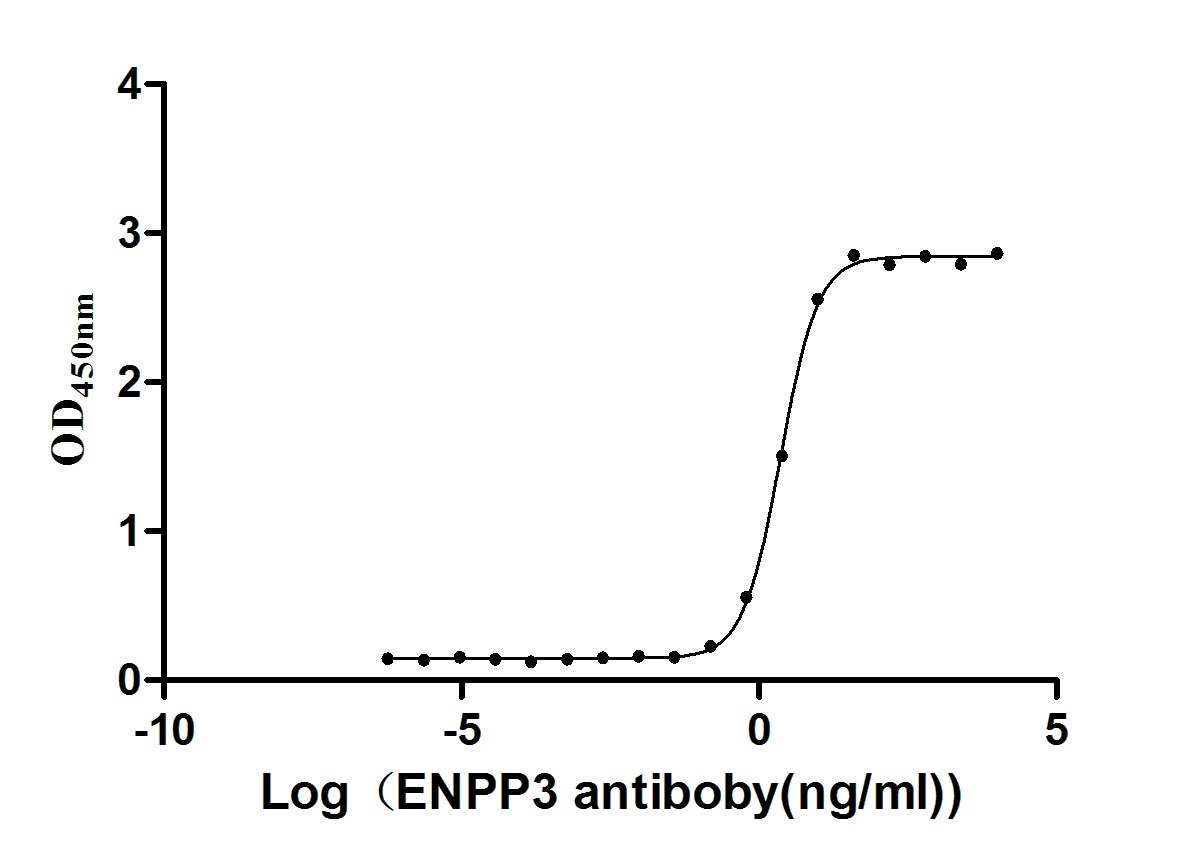Recombinant Human T-cell surface glycoprotein CD3 epsilon chain (CD3E), partial
In Stock-
中文名称:Recombinant Human T-cell surface glycoprotein CD3 epsilon chain(CD3E),partial
-
货号:CSB-YP004931HU
-
规格:¥1500
-
图片:
-
其他:
产品详情
-
纯度:Greater than 90% as determined by SDS-PAGE.
-
基因名:
-
Uniprot No.:
-
别名:CD3 epsilon; CD3e; CD3e antigen; CD3e antigen epsilon polypeptide (TiT3 complex); CD3E antigen epsilon polypeptide; CD3E antigen, epsilon subunit; CD3e molecule epsilon; CD3e molecule, epsilon (CD3 TCR complex); CD3e molecule, epsilon (CD3-TCR complex); CD3E_HUMAN; IMD18; T cell antigen receptor complex epsilon subunit of T3; T cell surface antigen T3/Leu 4 epsilon chain; T cell surface glycoprotein CD3 epsilon chain; T-cell surface antigen T3/Leu-4 epsilon chain; T-cell surface glycoprotein CD3 epsilon chain; T3E; TCRE
-
种属:Homo sapiens (Human)
-
蛋白长度:Extracellular Domain
-
来源:Yeast
-
分子量:13.8kDa
-
蛋白标签:N-terminal His-tagged/Tag-Free
-
产品提供形式:Liquid or Lyophilized powder
Note: We will preferentially ship the format that we have in stock, however, if you have any special requirement for the format, please remark your requirement when placing the order, we will prepare according to your demand. -
缓冲液:If the delivery form is liquid, the default storage buffer is Tris/PBS-based buffer, 5%-50% glycerol.
Note: If you have any special requirement for the glycerol content, please remark when you place the order.
If the delivery form is lyophilized powder, the buffer before lyophilization is Tris/PBS-based buffer, 6% Trehalose. -
储存条件:Store at -20°C/-80°C upon receipt, aliquoting is necessary for mutiple use. Avoid repeated freeze-thaw cycles.
-
保质期:The shelf life is related to many factors, storage state, buffer ingredients, storage temperature and the stability of the protein itself.
Generally, the shelf life of liquid form is 6 months at -20°C/-80°C. The shelf life of lyophilized form is 12 months at -20°C/-80°C. -
货期:3-7 business days
-
注意事项:Repeated freezing and thawing is not recommended. Store working aliquots at 4°C for up to one week.
-
Datasheet & COA:Please contact us to get it.
相关产品
靶点详情
-
功能:Part of the TCR-CD3 complex present on T-lymphocyte cell surface that plays an essential role in adaptive immune response. When antigen presenting cells (APCs) activate T-cell receptor (TCR), TCR-mediated signals are transmitted across the cell membrane by the CD3 chains CD3D, CD3E, CD3G and CD3Z. All CD3 chains contain immunoreceptor tyrosine-based activation motifs (ITAMs) in their cytoplasmic domain. Upon TCR engagement, these motifs become phosphorylated by Src family protein tyrosine kinases LCK and FYN, resulting in the activation of downs...显示更多
-
基因功能参考文献:
- The ionic CD3-epsilon -Lck interaction controls the phosphorylation level of the T-cell receptor. PMID: 28659468
- A novel pathogenic frameshift variant of CD3E gene has been found in two unrelated T-B+ NK+ severe combined immunodeficiency infants from Turkey. PMID: 28597365
- the stalk domains of NKp30 and NKp46, another NCR employing CD3zeta for signaling, were not exchangeable without drastic deficiencies in folding, plasma membrane targeting, and/or ligand-induced receptor signaling. PMID: 27754869
- The inducible recruitment of WASp to the TCR-CD3 complex is partially dependent of tyrosine phosphorylation of Cd3e. PMID: 26342115
- increase. Our results indicate that the change in CD3zeta-chain expression from the baseline is an independent predictor of residual and recurrent head and neck squamous cell carcinoma. PMID: 26888626
- Data suggest that HIV-1 gp41 transmembrane domain (TMD) directly interacts with TMDs of the T-cell receptor and it's CD3-antigen co-receptors (delta, gamma, and epsilon); these interactions appear to be involved in immune evasion mechanism of HIV-1. PMID: 26828096
- that Nck recruitment to the TCR is fundamental to mount an efficient T cell response in vivo, and that the Nck-CD3epsilon interaction may represent a target for pharmacological modulation of the immune response. PMID: 24470497
- ABCB1 homozygous 3435 TT carrier subjects showed the lowest Pgp activity compared with 3435 CT and CC carriers of renal transplant patients. PMID: 23216707
- Local changes in the lipid composition of TCR microclusters render the CD3epsilon cytoplasmic domain accessible during early stages of T cell activation. PMID: 23166358
- Results show that levels of CD3epsilon, CD25, CD68, and ICAM-1 mRNA in BCC biopsies may predict risk for new basal cell carcinomas. PMID: 21980389
- analysis of the transgenic integration site in immunodeficient tgepsilon26 human CD3epsilon transgenic mice PMID: 21203507
- Results suggest that generation of CD3varepsilon chain isoforms with different N-terminal sequence and pI is a general phenomenon. PMID: 19616027
- Recruitment of Nck by CD3 epsilon reveals a ligand-induced conformational change essential for T cell receptor signaling and synapse formation. PMID: 12110186
- T cell receptor can be recruited to a subset of plasma membrane rafts, independently of cell signaling and attendantly to raft clustering PMID: 12499387
- SCID is caused by a CD3E deficiency. PMID: 15546002
- CD3 expression was strong in normal proximal and distal tubular epithelium and in renal oncocytomas, weak in chromophobe carcinoma, and negative in clear cell carcinomas, in papillary renal cell carcinoma, and in a transitional cell carcinoma. PMID: 16308105
- The CD3 epsilon immune recognition receptor cytoplasmic domain binds to acidic and mixed phospholipid vesicles with a binding strength that correlates with the protein net charge and the presence of clustered basic amino acid residues. PMID: 17176095
- CD3epsilon-mediated signal transduction pathway is essential for this transformation process PMID: 17507663
- Notch-dependent cytoplasmic CD3 expression can only be achieved during the early phase of NK-cell differentiation. PMID: 17630354
- In lung adenocarcinoma patients, significant decreases of MFI values for CD3epsilon, but not CD3zeta, were found in CD4+T and CD8+T cells from pleural effusion compared to peripheral blood and in peripheral blood of patients compared to healthy donors. PMID: 17668204
- Data show that Nck forms a complex with an atypical PxxDY motif of the CD3epsilon tail, which encompasses Tyr166 within the activation motif and a T-cell receptor endocytosis signal. PMID: 18555270
- Data show that anti-CD3 monoclonal antibody (MAb)-mediated chimpanzee T-cell activation is a function of the anti-CD3 MAb isotype and is not governed by Siglec expression. PMID: 18667496
- Results revealed that the human CD3 epsilon subunit forms a homodimer structure, which provide insight into our understanding of the molecular assembly of the CD3 molecular complex. PMID: 19724882
收起更多
-
相关疾病:Immunodeficiency 18 (IMD18)
-
亚细胞定位:Cell membrane; Single-pass type I membrane protein.
-
数据库链接:


















